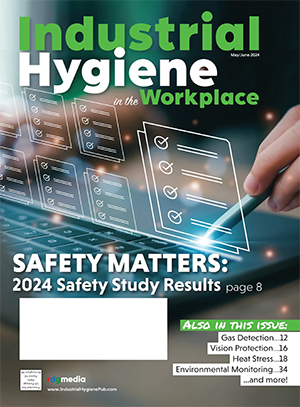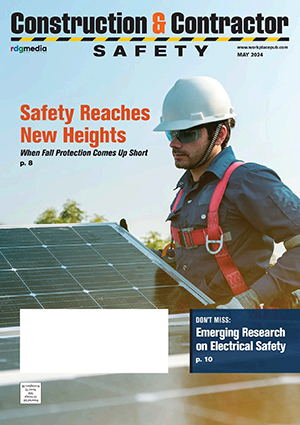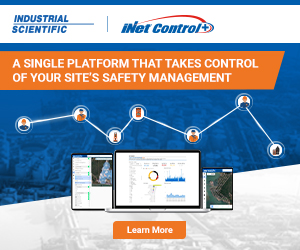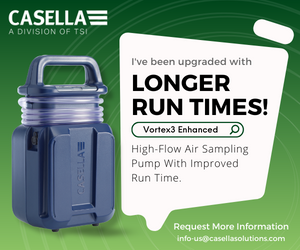The Exciting World of Safety Wearables: Protect Your People
By: Gen Handley, Contributor
Our world is more dependent on technology than ever—particularly when it comes to occupational safety. A major reason for that is the simple importance of connectivity, as well as a healthy communication culture where employees are actively engaged in work safety and in choosing the technology and devices that help monitor and protect them.
An important and exciting segment of the broad work-safety technology category is wearable technology, or “wearables,” compact devices worn on existing equipment and clothing or small enough to be embedded into fabrics and textiles. Employees wear these technologies which can monitor different, important metrics related to their safety and well-being, such as blood pressure, location tracking, body temperature, heart rate, stress, impact and fall protection technology—as well as dangerous chemicals and gases in the area.

With improved connection, safety wearables can improve the employer’s response to emergencies and accidents involving workers. © Platoo Studio – stock.adobe.com
History of Safety Wearables
Innovation in wearable technology has come a long way; it actually began with the now-common pair of eyeglasses, first introduced in the 13th century. From correcting and protecting a person’s eyesight, safety wearables can now detect dangerous impact and substances, and cool workers down when it’s too hot, allowing them to communicate with their coworkers and other sources for help.
All of this innovation in wearable technology has the potential to benefit employees and workers in a broad range of industries and positions, especially those working in higher risk environments, such as lone workers and those working from heights.
Benefits Of Wearables
Like the different types of jobs they help protect, the span of benefits is just as diverse, impacting different, key areas of occupational safety.
Improved Communication
The most important benefit of safety wearables in the workplace is how much easier communication is when using them—such as wireless, hard hat-mounted headsets—and how employees can remain connected with their coworkers, at all times, through well-designed devices and technology.
Faster/Optimized Emergency Response
With improved connection, safety wearables can also improve the employer’s response to emergencies and accidents involving workers. If an employee injures themself and is unable to request emergency help, a safety wearable can request that help for them.
Refined Safety Data Reporting
While a person is performing their work and using a safety wearable, it can be used to measure various metrics, including ergonomics and dangerous repetitive body movements. This can help prevent painful musculoskeletal disorders (MSDs) that occur when not addressed properly. Also, this technology will quantify work environment temperatures and conditions, as well as the worker’s fatigue levels—which can be provided in valuable safety reports.
Attested/Proven Safety Monitoring
An employee’s location and overall safety can be monitored more effectively, in real-time, and in circumstances which they can easily request help. This includes a worker feeling threatened or in danger, as well as if they are unconscious and require immediate medical attention. Additionally, in an accident or crisis, emergency responders will benefit from location tracking, knowing the correct location to send immediate help.

Safety wearables can be used to measure various metrics, including ergonomics and dangerous repetitive body movements. © sirisakboakaew – stock.adobe.com
Benefits for Employers & Employees
There are mutual benefits for both the employer and employees, creating a strong argument to use some type of wearable in the workplace as a proactive safety measure.
The most significant benefit is increased safety awareness for those wearing the devices, as well as those viewing the safety data. Whichever OHS metric the wearable is measuring or monitoring, everyone is actively engaged in the workers’ safety.
With so much different data collected by safety wearables, employers can leverage it to look at past mistakes or identify dangerous patterns, benefiting initiative-taking incident management. This data—and the revealing safety reports it creates—can be very revealing, sometimes allowing employers to take steps that prevent accidents from taking place.
Additionally, when employees’ safety is secure and monitored, there is a positive impact on worker morale within the company. The employer is not required to spend as much time and human resources on their number-one priority: employees’ safety. In addition, the employee does not need to worry as much about their safety, knowing that help will be requested if they need it.
Challenges and Considerations
While there are many major benefits, there are some challenges that may come with the adoption of safety wearables in your workplace.
The first concerns the privacy and data security of the workers’ data, as previously discussed. Employers must take all steps possible to secure the data collected by safety wearables and ensure its confidentiality.
Safety wearable users may also experience adoption challenges, with possible difficulties integrating the devices into their jobs and daily tasks. Some wearables may require some training and might not be able to be used immediately. When researching the device beforehand, the amount of time and work required to onboard your team should be a major consideration.
Also, a major challenge for these technologies is that they’re not accessible to everyone and may be costly. While the costs are coming down, most safety wearables are not as affordable as commonplace PPE. However, if you can determine its efficacy against an occupational hazard or danger that could potentially hurt workers, then the cost can be justified.
The Future of Wearables
What does the future hold for this exciting industry? In addition to continuing to benefit more diverse types of jobs and industries, safety wearables will also become smaller—continuing down the path of nanotechnology and smart textiles.
OHS wearables are part of a growing trend towards automated safety where workers need not worry about their well-being on the job—because a wearable device or safety app is doing that. With so much on the line, employers should explore if there are safety devices that can increase the safety of their most valuable resource: their people. IHW
Gen Handley is Marketing and Growth Coordinator, Tsunami Solutions Ltd., gen.handley@safetylineloneworker.com
Share on Socials!
Blackline Safety Expands Manufacturing Capacity to Meet Growing Customer Demand
Industrial Hygiene and Job Planning During Turnarounds
Atmospheric Hazards at Commercial Cannabis Grower & Processor Facilities
Leaders in Industrial Hygiene
Council for Accreditation in Occupational Hearing Conservation (CAOHC)
Subscribe!
Sign up to receive our industry publications for FREE!








